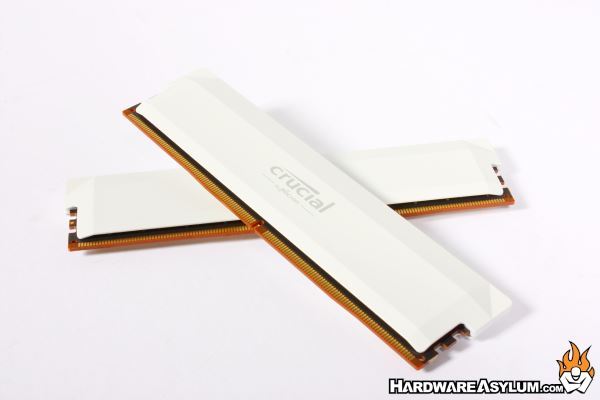Crucial Pro Series DDR5 6000MT/s Overclocking Memory Review
Author: Dennis GarciaMemory specifications and Conclusion
Something that I often “gloss over” with my memory reviews is “how do you activate Overclocking memory?” like the Crucial Pro Series Overclocking Memory Modules.
Well, you do this through XMP and EXPO memory profiles.
By default, when you install any memory module, they will revert to the basic JEDEC spec setting. This is programmed into the motherboard UEFI and on the module EEPROM so that the motherboard maker will know the default settings. Remember when I talked about how JEDEC sets a standard? Well, this is one of the reasons for that.
Some OEM manufacturers make assumptions on the types of memory will be available in their systems and will program the UEFI to use a performance profile instead of a JEDEC profile. This will ensure that your OEM build will always perform well out of the box
For a DIY system build or a custom build from a boutique system builder you will need to become familiar with the UEFI BIOS and how to enable a memory profile. There is no harm if you leave everything at the factory settings but, by enabling the profile you unlock the hidden potential of the memory you paid good money for.

Crucial Pro Overclocking Memory comes with several profiles that you can choose from. Each will have a specified frequency and timing map and you will select the profile based on your processor.
XMP generally means Intel
EXPO generally means AMD
Generally speaking, these are almost always identical configurations but may have slightly different sub-settings or voltage configurations.
Default(JEDEC) | 5600MT/s 46-45-45 |
XMP 3.0 Profile 1 | 6000MT/s 36-38-38-80 |
XMP 3.0 Profile 2 | 5600MT/s 36-38-38-80 |
EXPO Profile 1 | 6000MT/s 36-38-38-80 |
EXPO Profile 2 | 5600MT/s 36-38-38-80 |
Voltage | 1.35v |
What I like about these memory profiles is that they are running the enhanced JEDEC frequency and the only major difference between the two enhanced XMP/EXPO profiles is the frequency. This is to accommodate systems that may not support the higher memory frequency but will work with the enhanced timings.
This goes back to the OEM system situation where the memory frequency is pre-programmed and this gives you can option to offer better performance without impacting stability.
Currently you can acquire the Pro OC Edition memory as individual modules in both 16GB and 24GB densities or as dual channel kits with maximum densities of 36GB and 48GB respectively. Both configurations offer the same speed grades of 6000Mhz (MT/s) and timings of CL36. It goes without saying that DDR5 does have profound performance advantages over DDR4 so, if you are in the market, you owe it to yourself to go DDR5.
In terms of performance the DDR5-6000Mhz modules live up to their “Overclocking” roots but only so far as enabling an XMP/EXPO profile that is above the accepted JEDEC standards. Pushing these modules beyond the 6000Mhz limit is not all difficult however voltage limitations will severely hinder any performance gains you will get. With that being said I was able to boot the test system at 6600Mhz but ultimately lowered to 6500Mhz to improve memory timings and stability. Sadly, the end result was not worth the effort given that just about every benchmark kicked out the same performance numbers.
While I tend to focus on performance in my reviews there are only a few instances where overall memory speed makes a difference in modern DDR5 computer systems. As many of our benchmarks show there is a nice performance improvement when moving to higher speed memory and you should strive to get the fastest modules you can afford. The 6200Mhz range is currently a sweet spot with DDR5 memory offering a good mix of timings and frequency while still showing noticeable gains in performance. The Crucial Pro Memory: Overclocking edition modules offer a 6000Mhz speed grade and some amazing out of box performance due to the CL36 timings. Sure, you can buy faster modules but, when you buy Crucial you also buy into their long track record of reliability and system compatibility.
Legendary Crucial Compatibility
Great Performance
Expanded Frequency Options
Dual XMP/EXPO Memory Profiles
Simple Heatspreader Design
Not friendly to manual overclocks
Simple heatspreader design

